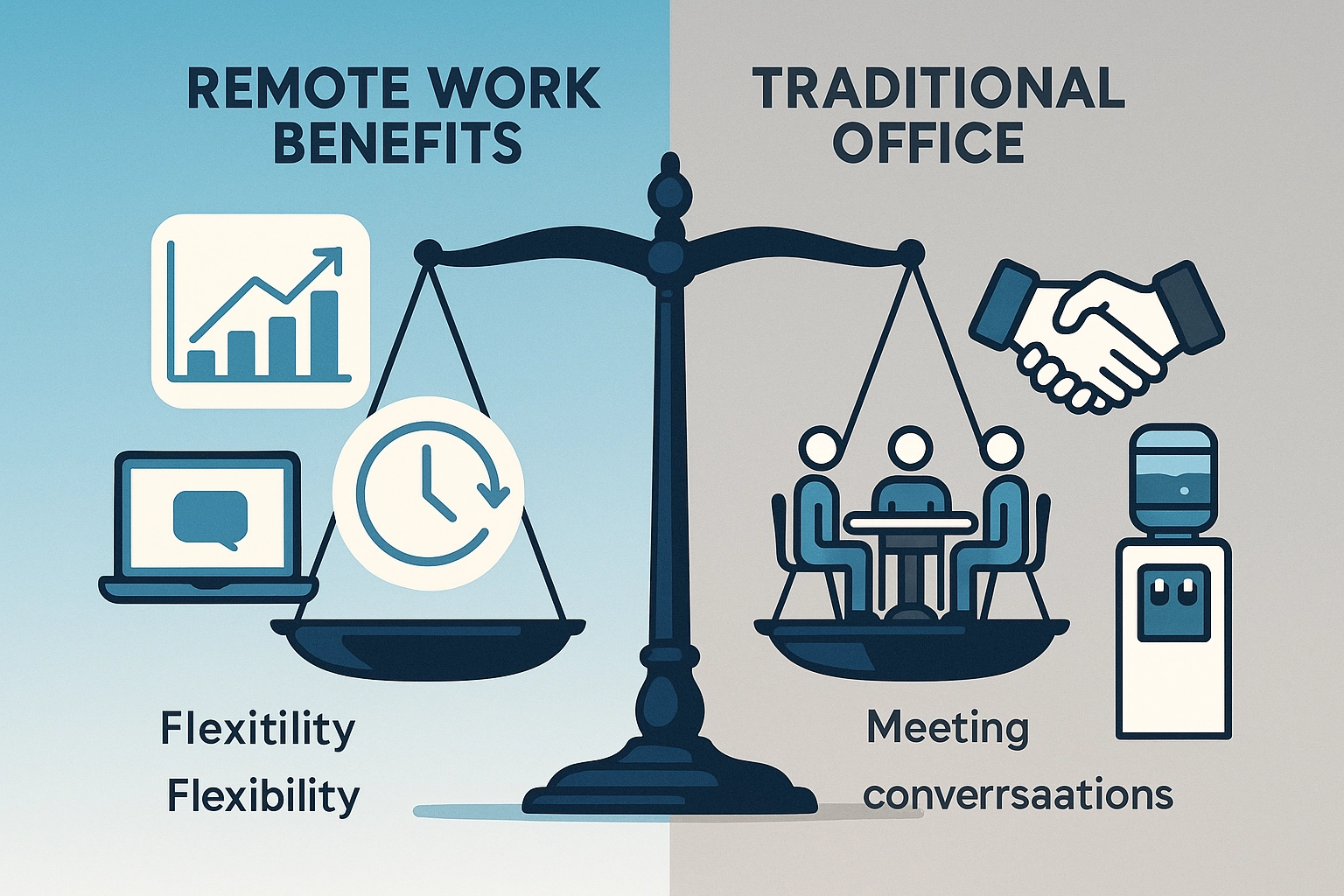The modern workplace looks dramatically different than it did just a few years ago. With five generations now working side by side: from Silent Generation to Gen Alpha: and remote work becoming mainstream, leaders face a complex challenge: how do you effectively manage a multi-generational team when everyone has different expectations about leadership style, communication, and work environment?
The answer isn't as simple as choosing one approach over another. Let's dive deep into both remote and traditional leadership models to help you determine what works best for your unique team composition.
Understanding Your Multi-Generational Landscape
Before we compare leadership approaches, it's crucial to understand what you're working with. Today's workforce spans multiple generations, each bringing distinct preferences and expectations:
Baby Boomers typically value formal structures, annual performance reviews, and hierarchical communication. They often prefer face-to-face meetings and appreciate clear authority lines.
Generation X bridges the gap between traditional and digital approaches. They value independence but also appreciate structured feedback and clear expectations.
Millennials expect continuous feedback, collaborative decision-making, and flexibility. They're comfortable with digital communication but still value personal relationships.
Generation Z are digital natives who prefer quick, informal communication and expect real-time feedback. They value authenticity and purpose-driven leadership.

The Remote Leadership Advantage
Remote leadership has proven itself more than just a pandemic necessity: it's become a powerful management approach with measurable benefits. Research shows that remote employees are 47% more productive than their office counterparts, with 50% lower attrition rates. But what makes remote leadership particularly effective for multi-generational teams?
Flexibility That Speaks to Everyone
Remote leadership naturally accommodates different generational preferences through adaptable communication methods. You can provide frequent check-ins for team members who prefer detailed guidance while offering greater autonomy to those who thrive with less supervision. This flexibility allows you to meet each generation where they are, rather than forcing everyone into a one-size-fits-all approach.
Digital-First Opportunities
The remote environment creates unique opportunities for reverse mentoring: where younger employees share their digital fluency while older team members contribute institutional knowledge and industry insights. This mutual exchange breaks down traditional hierarchical barriers and leverages the strengths of each generation.
Outcome-Focused Management
Remote leadership naturally shifts focus from time-in-seat to results-delivered. This appeals to younger generations who value work-life balance while still meeting the productivity expectations of more traditional workers. The emphasis on outcomes rather than process can be liberating for all generations when implemented correctly.

The Traditional Leadership Foundation
Traditional, in-person leadership shouldn't be dismissed as outdated. It offers several advantages that remain relevant for multi-generational teams, particularly when relationship-building and complex collaboration are priorities.
The Power of Physical Presence
Face-to-face interaction enables immediate communication and spontaneous collaboration opportunities. Leaders can observe non-verbal cues, body language, and team dynamics more effectively, facilitating better emotional intelligence application and relationship building. This is particularly valuable when managing sensitive situations or building trust with team members who prefer personal interaction.
Natural Mentorship Opportunities
Traditional office environments enable organic mentorship moments: those coffee break conversations and hallway encounters where knowledge transfer happens naturally. For multi-generational teams, these informal interactions can be incredibly valuable for building mutual understanding and respect across age groups.
Structured Communication Benefits
Traditional leadership often accommodates the preferences of older generations who value formal annual performance reviews and structured hierarchical communication. This approach can provide the clarity and predictability that some team members need to perform their best.
Head-to-Head Comparison
| Factor | Remote Leadership | Traditional Leadership |
|---|---|---|
| Productivity | 47% higher productivity, 50% lower attrition | Variable, dependent on management style |
| Flexibility | High adaptability to individual preferences | Limited by physical and structural constraints |
| Communication | Multiple digital channels, asynchronous options | Immediate face-to-face, body language reading |
| Trust Building | Requires intentional effort and transparency | Benefits from informal, spontaneous interactions |
| Feedback Delivery | Challenging for difficult conversations | More natural and immediate |
| Cross-Generational Learning | Structured reverse mentoring opportunities | Organic knowledge transfer moments |
| Work-Life Balance | Appeals to younger generations | May favor traditional expectations |

When Remote Leadership Wins
Remote leadership is your best bet when your team composition includes a significant number of Millennials and Gen Z workers who value flexibility and continuous feedback. It's also ideal when:
- Geographic diversity is important for your business strategy or talent acquisition
- Productivity and employee satisfaction are primary concerns that need immediate attention
- Your organization can invest in robust digital communication infrastructure
- You're managing knowledge workers who can perform effectively with minimal physical oversight
The key to successful remote leadership with multi-generational teams is implementing virtual team-building activities that appeal to various generational interests while maintaining regular communication rhythms that work for everyone.
When Traditional Leadership Still Rules
Choose traditional leadership when your team composition skews toward Baby Boomers and Gen X workers who prefer formal structures and face-to-face interaction. It's also the better choice when:
- Complex collaborative projects require intensive coordination and real-time problem-solving
- Building deep interpersonal relationships is critical for your business model
- Your industry requires physical presence, hands-on training, or equipment operation
- Cultural change initiatives need the nuanced communication that comes with in-person leadership

The Hybrid Sweet Spot
For most multi-generational teams, the optimal solution isn't choosing one approach over another: it's creating a thoughtful hybrid model that leverages the strengths of both approaches.
This might look like maintaining remote work flexibility while scheduling regular in-person sessions for relationship building, complex project collaboration, and team alignment. The key is being intentional about when and why you choose each approach, rather than defaulting to what feels comfortable or familiar.
Implementation Strategies
Start with individual preferences: Survey your team members about their communication and feedback preferences. Don't assume you know what each generation wants: individuals within generations can vary significantly.
Create structured flexibility: Establish core hours or days when everyone is available (whether virtually or in-person) while allowing autonomy in other areas.
Leverage technology thoughtfully: Use digital tools to enhance rather than replace human connection. Video calls for important discussions, collaborative platforms for project work, and messaging apps for quick check-ins can create a comprehensive communication ecosystem.
Focus on outcomes: Regardless of where and how work gets done, maintain clear performance expectations and measurement systems that work across all generations and work environments.
Making Your Decision
The choice between remote and traditional leadership for your multi-generational team ultimately depends on your specific context: your industry, team composition, business objectives, and organizational culture. The most effective leaders recognize that this isn't about choosing a side: it's about choosing the right tool for each situation and team member.
Remember that effective leadership requires adaptability and emotional intelligence regardless of format. Whether you're leading virtually or in-person, your success will depend on your ability to connect with each team member in ways that motivate and inspire them to do their best work.
The future belongs to leaders who can fluidly move between approaches, meeting their team members where they are and adapting their style to bring out the best in every generation. Start by understanding your team's unique composition and preferences, then build a leadership approach that honors both individual needs and collective goals.

